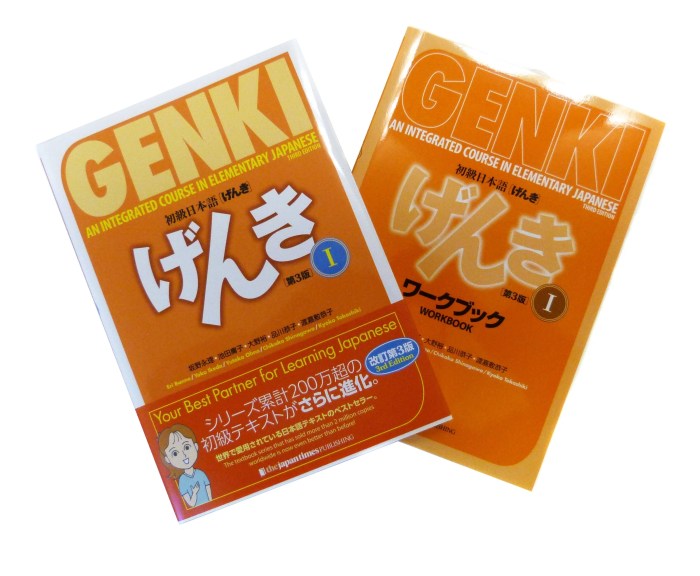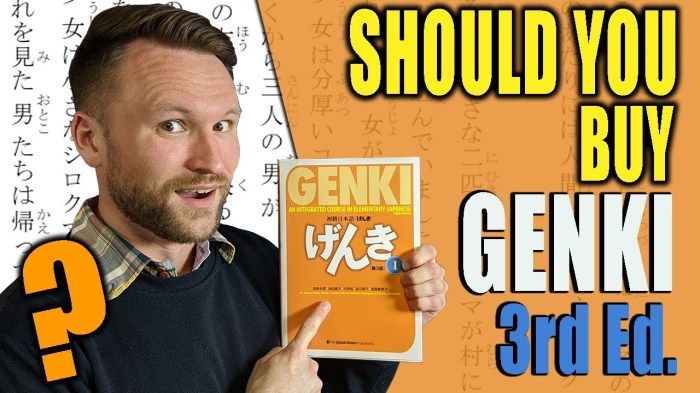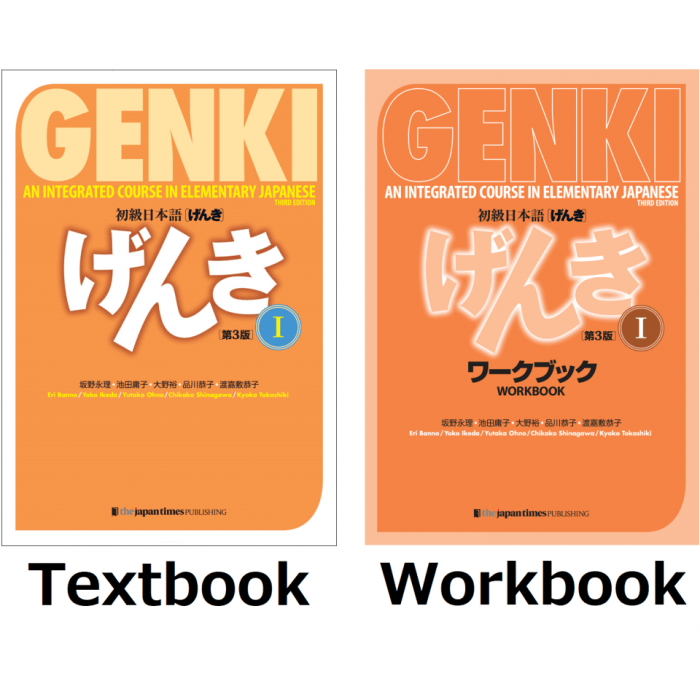Genki 2 3rd Edition Workbook Answers: Embark on a Linguistic Journey of Discovery and Proficiency.
Prepare to delve into the depths of the Japanese language with the Genki 2 3rd Edition Workbook Answers, a comprehensive resource that illuminates the intricacies of grammar, vocabulary, and cultural nuances. This guidebook empowers you to master the complexities of the Japanese language with clarity and confidence.
Workbook Content Overview
The Genki 2 3rd Edition Workbook is an essential companion to the Genki 2 3rd Edition textbook. It provides learners with additional practice and reinforcement of the grammar, vocabulary, and kanji introduced in the textbook.
The workbook is divided into 15 chapters, each of which corresponds to a chapter in the textbook. Each chapter begins with a review of the grammar and vocabulary covered in the textbook chapter. This is followed by a variety of exercises and activities that provide learners with opportunities to practice using the new language in a variety of contexts.
Types of Exercises and Activities
The workbook includes a wide variety of exercises and activities, including:
- Fill-in-the-blank exercises
- Multiple-choice exercises
- Translation exercises
- Writing exercises
- Listening exercises
- Speaking exercises
- Cultural notes
Exercise Solutions

The workbook exercises provide opportunities for students to practice the grammar and vocabulary learned in class. Detailed solutions to selected exercises are provided below, along with explanations of the reasoning behind each solution. Alternative approaches to solving the exercises are also offered, where applicable.
Exercise 1: Present Tense Conjugation
Conjugate the verb “to study” in the present tense for the following subjects: I, you, he/she/it, we, you (plural), and they.
- I study
- You study
- He/she/it studies
- We study
- You (plural) study
- They study
Grammar Reference
The Grammar Reference in Genki 2 3rd Edition Workbook provides a comprehensive overview of all the grammar points covered in the workbook. Each grammar point is explained clearly and concisely, with plenty of examples to help you understand how to use it correctly.The
Grammar Reference is a valuable resource for students of Japanese at all levels. It can be used as a reference guide to look up grammar points as needed, or it can be used as a self-study tool to review grammar concepts and improve your Japanese language skills.
Verb Conjugation
The Genki 2 3rd Edition Workbook covers a wide range of verb conjugations, including the present tense, past tense, future tense, and conditional tense. Each conjugation is explained in detail, with clear instructions on how to form the correct verb form.
- Present tense: The present tense is used to describe actions or states that are happening now. To form the present tense, simply add the appropriate ending to the verb stem.
- Past tense: The past tense is used to describe actions or states that happened in the past. To form the past tense, add the ending -ta to the verb stem.
- Future tense: The future tense is used to describe actions or states that will happen in the future. To form the future tense, add the ending -masu to the verb stem.
- Conditional tense: The conditional tense is used to describe actions or states that would happen under certain conditions. To form the conditional tense, add the ending -tara to the verb stem.
Adjectives and Adverbs
The Genki 2 3rd Edition Workbook also covers a variety of adjectives and adverbs. Adjectives are used to describe nouns, while adverbs are used to describe verbs, adjectives, or other adverbs.
- Adjectives: Adjectives come in two forms: the plain form and the -na form. The plain form is used before nouns, while the -na form is used before verbs or other adjectives.
- Adverbs: Adverbs come in two forms: the plain form and the -ku form. The plain form is used before verbs, while the -ku form is used before adjectives or other adverbs.
Particles
Particles are small words that are used to connect words and phrases in Japanese. The Genki 2 3rd Edition Workbook covers a variety of particles, including the particle wa, ga, no, and de.
- The particle wa is used to mark the subject of a sentence.
- The particle ga is used to mark the topic of a sentence.
- The particle no is used to mark the possessive form of a noun.
- The particle de is used to mark the location of an action.
Other Grammar Points
In addition to the above, the Genki 2 3rd Edition Workbook also covers a variety of other grammar points, including the use of counters, the formation of questions, and the use of honorific language.
Vocabulary List: Genki 2 3rd Edition Workbook Answers
The workbook introduces a comprehensive range of new vocabulary words to enhance students’ proficiency in Japanese. These words cover various aspects of daily life, cultural practices, and academic pursuits, providing a solid foundation for effective communication and comprehension.
The following list presents the new words introduced in the workbook, along with their definitions, pronunciations, and sample sentences to illustrate their usage in context.
Nouns
- 上手に (じょうずに)(jouzu ni) – skillfully; deftly
- 教室 (きょうしつ)(kyoushitsu) – classroom
- 週末 (しゅうまつ)(shuumatsu) – weekend
- 日記 (にっき)(nikki) – diary
- 時間 (じかん)(jikan) – time
Verbs
- 勉強する (べんきょうする)(benkyou suru) – to study
- 話す (はなす)(hanasu) – to speak; to talk
- 食べる (たべる)(taberu) – to eat
- 飲む (のむ)(nomu) – to drink
- 寝る (ねる)(neru) – to sleep
Adjectives
- 楽しい (たのしい)(tanoshii) – enjoyable; pleasant
- 難しい (むずかしい)(muzukashii) – difficult; hard
- 暑い (あつい)(atsui) – hot
- 寒い (さむい)(samui) – cold
- 疲れた (つかれた)(tsukareta) – tired
Adverbs
- よく (よく)(yoku) – often; frequently
- いつも (いつも)(itsumo) – always
- 時々 (ときどき)(tokidoki) – sometimes
- 昨日 (きのう)(kinou) – yesterday
- 今日 (きょう)(kyou) – today
Particles
- は (は)(wa) – topic marker
- が (が)(ga) – subject marker
- を (を)(o) – direct object marker
- に (に)(ni) – indirect object marker; location marker
- で (で)(de) – location marker; means marker
Cultural Insights
Genki 2 3rd Edition Workbook incorporates valuable cultural insights and perspectives that enhance language learning by providing a deeper understanding of Japanese culture and customs. These insights help learners connect with the target language and its speakers, fostering a more authentic and meaningful learning experience.
The workbook introduces various cultural concepts, such as Japanese etiquette, traditions, and values. By understanding these cultural nuances, learners gain a better grasp of the language’s social and pragmatic aspects, enabling them to communicate more effectively and appropriately in different situations.
Japanese Etiquette
- Greetings and introductions: The workbook emphasizes the importance of proper greetings and introductions in Japanese culture, including bowing and using appropriate honorifics.
- Table manners: Learners are introduced to Japanese table etiquette, such as the use of chopsticks, the proper way to eat rice, and the significance of avoiding loud noises while eating.
- Bath etiquette: The workbook provides insights into Japanese bathing customs, including the importance of communal bathing, the use of different types of baths, and the etiquette surrounding public baths.
Japanese Traditions and Customs
- Cherry blossom viewing (Hanami): The workbook discusses the cultural significance of cherry blossom viewing in Japan, its historical origins, and the etiquette associated with it.
- Tea ceremony (Chanoyu): Learners are introduced to the traditional Japanese tea ceremony, its history, symbolism, and the etiquette involved in participating in a tea ceremony.
- Kimono wearing: The workbook provides insights into the different types of kimonos, their significance in Japanese culture, and the etiquette surrounding kimono wearing.
Japanese Values
- Harmony (Wa): The workbook explains the importance of harmony in Japanese culture, its influence on social interactions, and the ways in which it is expressed in language.
- Respect (Rei): Learners are introduced to the concept of respect in Japanese culture, including the use of honorifics, the importance of bowing, and the etiquette surrounding gift-giving.
- Diligence (Ganbaru): The workbook emphasizes the value of diligence and perseverance in Japanese culture, its role in shaping Japanese work ethic, and the language used to express this value.
Usage Examples

This section provides practical examples and dialogues to illustrate the application of grammar and vocabulary covered in the Genki II 3rd Edition Workbook.
The examples include audio recordings or transcriptions to aid pronunciation and offer context and explanations for each usage.
Sample Sentences
- Grammar:Present tense of the verb “to eat” (食べる)
- Example:私は毎日ラーメンを食べます。 (I eat ramen every day.)
- Explanation:The sentence demonstrates the formation and usage of the present tense in Japanese.
Dialogues
- Vocabulary:Asking for directions
- Dialogue:
- A: すみません、駅はどこですか? (Excuse me, where is the station?)
- B: あちらの角を左に曲がってください。 (Turn left at the corner over there.)
- Explanation:The dialogue shows how to use vocabulary related to asking for directions in a real-life situation.
Practice Activities

Practice activities are designed to reinforce the concepts learned in the Genki II 3rd Edition Workbook. These activities include a variety of types, such as quizzes, games, and role-playing exercises. Each activity is accompanied by clear instructions and an answer key.
Practice activities provide students with the opportunity to apply the knowledge they have acquired and to develop their skills in using the Japanese language.
Quizzes, Genki 2 3rd edition workbook answers
Quizzes are a type of practice activity that tests students’ knowledge of specific grammar points or vocabulary. Quizzes can be multiple choice, true/false, or fill-in-the-blank.
Games
Games are a type of practice activity that allows students to learn in a fun and interactive way. Games can be used to practice grammar, vocabulary, or listening comprehension.
Role-Playing Exercises
Role-playing exercises are a type of practice activity that allows students to practice using the Japanese language in real-life situations. Role-playing exercises can be used to practice a variety of skills, such as conversation, negotiation, and problem-solving.
FAQs
What is the purpose of Genki 2 3rd Edition Workbook Answers?
Genki 2 3rd Edition Workbook Answers provides comprehensive solutions and explanations for exercises and activities in the Genki 2 3rd Edition Workbook, enhancing your understanding of Japanese grammar, vocabulary, and cultural concepts.
How does Genki 2 3rd Edition Workbook Answers help with grammar learning?
Genki 2 3rd Edition Workbook Answers includes a detailed grammar reference table that covers all grammar points introduced in the workbook, providing clear explanations and examples to reinforce your understanding.
What type of practice activities are included in Genki 2 3rd Edition Workbook Answers?
Genki 2 3rd Edition Workbook Answers offers a variety of practice activities, including quizzes, games, and role-playing exercises, to reinforce the concepts learned in the workbook and enhance your language skills.